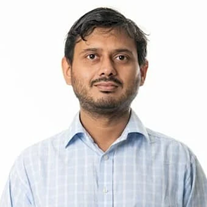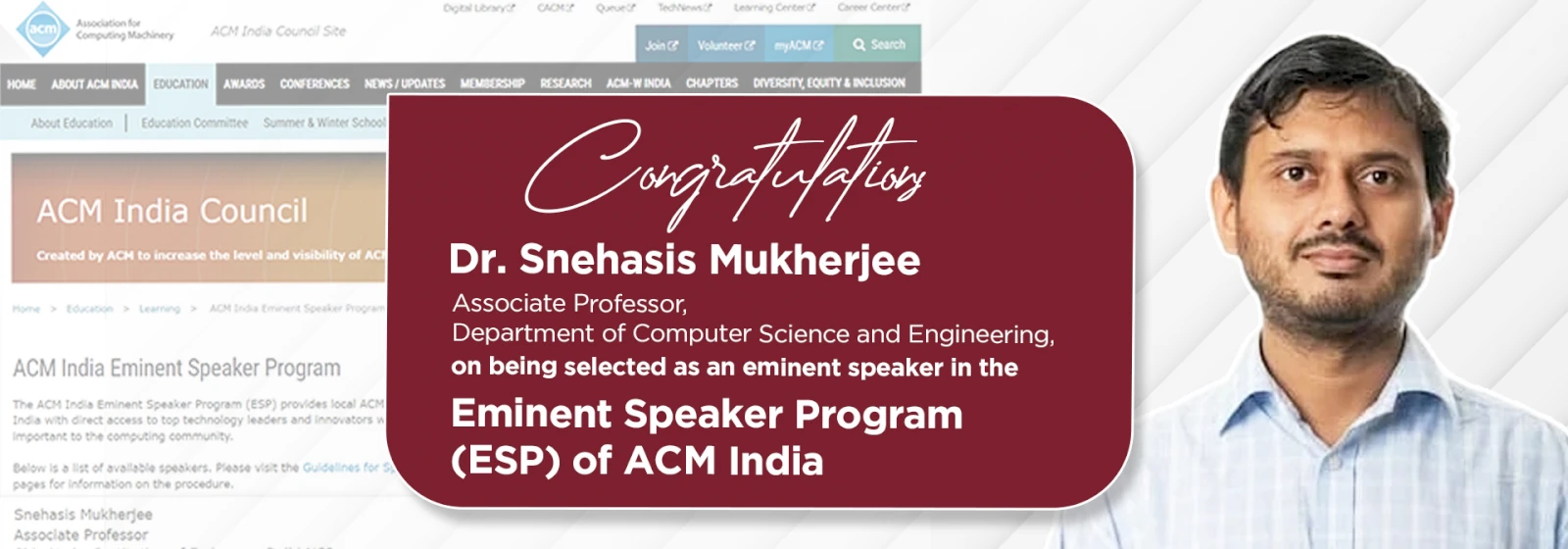SNIoE Faculty Member Selected as Eminent Speaker by the Association for Computing Machinery India
When Shiv Nadar Institute of Eminence (SNIoE) stepped into its second decade in 2021, a message from the Dean formalised the focus of the university’s future research, which was agreed upon after extensive discussion. Some of these focal points were “Data and Computation” and “Digital Transformation,” as well as “Analytics.” A key centre at which these areas of research are practiced is the Department of Computer Science and Engineering, one of the institute’s largest departments. This department is home to groundbreaking advancements in algorithms and complexity, natural language processing, image processing, social network analysis, computational biology, computer vision, data mining, cybersecurity and privacy, Internet of Things, wireless and mobile computing, big data analytics, and more. At the forefront of research efforts in the department is Associate Professor Dr. Snehasis Mukherjee, who was recently selected as an Eminent Speaker by the Association for Computing Machinery (ACM) India. This prestigious position, which Dr. Mukherjee will hold from April 2024 to March 2026, represents a huge milestone in his career and a great achievement to SNIoE as a whole. During this period, Dr. Mukherjee will give talks on contemporary matters related to his research, which deal with current issues and hot topics within the computing community. His first talk, Engineering on Supervised Network for Training with Less Data, is centred around making supervised networks more efficient through careful engineering. In a study recently published in the high-impact journal IEEE Transactions on Artificial Intelligence, Dr. Mukherjee and Jaydeep Kishore—his student at the Department of Computer Science and Engineering, SNIoE, at the time—investigated a novel method to optimise self-supervised models in order to simultaneously overcome one of their glaring issues. “In contrast to supervised models, which need to be trained on large datasets with (sometimes manually) labelled data, self-supervised models can learn underlying patterns in data by themselves,” explains Dr. Mukherjee in an exclusive interview. “However, if a large model is intended to be used for a more narrow or specific task, its internal parameters first need to be tuned, which consumes huge amounts of computational resources.” Through an innovative strategy involving statistical techniques, the researchers managed to efficiently ‘transfer’ or adapt the knowledge of the generic model to a specialised task. In another study, published in Neurocomputing, Dr. Mukherjee and his team—Mohammad Farazuddin, who was then an undergraduate student at the Indian Institute of Information Technology (IIIT) Sri City; S.H. Shabbeer Basha, who was a Ph.D. scholar at IIIT Sri City at the time; Shiv Ram Dubey, who was an Assistant Professor at IIIT Sricity at the time; and Viswanath Pulabaigari, currently Associate Professor at IIIT Sricity—developed a novel compression method that can significantly reduce the storage and computational complexity of deep convolutional neural network (CNN) models. By analysing the evolution of the model during the training phase, the proposed strategy can prune unnecessary sections of the CNN architecture without causing performance issues. In his second talk, Dr. Mukherjee will address an emerging and highly important area of research in computer vision: egocentric activity recognition. In AI-based security systems, self-driving cars, and other computer vision applications, automatically recognising what humans are doing in the video footage can be extremely helpful. However, in egocentric activity recognition, the perspective is flipped from a third-party observer to the first person. “In ‘egocentric videos,’ which are typically captured from a camera on top of a person’s head, AI models are tasked with being able to tell not what another person is doing, but what the wearer themself is doing. These can be daily activities such as opening a refrigerator, closing a door, and so on,” explains Dr. Mukherjee. The benefit of making progress in this particular field branches out to many commercial and industrial areas. For example, egocentric activity recognition can be used to generate training datasets for humanlike robots, as well as to remotely monitor the health of patients. Tying in with his second talk, his third talk deals with motion analysis in videos and how this field has evolved. As previously stated, analysing video footage to determine what people are doing can be leveraged in surveillance systems, smart retail applications, and even advanced human–computer interactions. In a paper published earlier this year, in the Proceedings of the Fourteenth Indian Conference on Computer Vision, Graphics and Image Processing (ICVGIP ‘23), Dr. Mukherjee presents a novel system for skeleton-based action recognition with co-author Tanishka Yagneshwar, an undergraduate student at the Department of Computer Science and Engineering, SNIoE. Together, they have developed a model for activity recognition that can leverage not only the instant position of the skeleton nodes at a given time, but also leverage more comprehensive information from previous positions during a given motion. It is worth noting that Dr. Mukherjee plans on revisiting each of these particular fields to bring them together under the umbrella of what’s known as ‘domain adaptation.’ This evolving area of research involves taking an existing model, which presumably has been trained on a generic task, and adapting it to a more specific task. “One example is the detection of tumors on MRI scans using a model that was trained on more general images; a sub-model capable of such a feat would save medical researchers the challenge of amassing large datasets of tumor data,” he remarks. In another study that he published alongside Jaydeep Kishore in Machine Intelligent Research, Dr. Mukherjee investigated the performance gains obtained in image classification models by adopting a special network architecture that ‘autotunes’ the parameters of self-supervised models so that they are efficiently adapted to a given task, such as image recognition. Meanwhile, in an article published in Image and Vision Computing, Dr. Mukherjee along with his student R.S. Jaisurya of the Department of Computer Science and Engineering, SNIoE, developed a special network architecture that can effectively remove haze from real-world images. This feat was achieved in an unsupervised network, greatly simplifying the training process. Saying that machine learning and artificial intelligence are becoming increasingly important in many applied and research fields would be a massive understatement. According to Dr. Mukherjee, “Machine learning is a really big field that boils down to one thing: you have data, and you analyse it using a trained model. The only requirement is that you can transform your data into a format compatible with a machine learning tool, but this is already the case with many areas, from hard sciences like chemistry and physics to sociology and economics. It is applicable virtually everywhere, really.” To illustrate this point, he brought up another of his papers which was published in the Journal of Supercomputing last year. In this paper, which was co-authored with Viswanatha Reddy G, Chaitanya BSNV, Prathyush P, Sumanth M, Mrinalini C, and Dileep Kumar P—students of IIIT Sri City at the time of research—an innovative strategy to predict the popularity of social media content over time was reported, taking into account several factors that were ignored in existing models. Such a method could be promptly leveraged for effective marketing, social activism, and brand monitoring. In line with the goals of ACM India’s Eminent Speaker Program, Dr. Mukherjee hopes to attract more young minds in India to the field of machine learning and computing in general. He remarks on the enthusiasm and motivation that he witnessed from undergraduate researchers in SNIoE; he cites them as major sources of inspiration and key collaborators in much of his research advancements. Hopefully, his talks will make more people aware of (and invested in) the vast capabilities of machine learning. With any luck, advances in this exciting field will lead to a more sustainable future. “Sustainability has many legs, so to say, and AI and machine learning can definitely contribute something to each of them,” he concludes. Let us wish Dr. Mukherjee and his students the best of luck with their research endeavours!

Dr. Snehasis Mukherjee
Associate Professor
School of Engineering, Shiv Nadar Institute of Eminence Website: https://sites.google.com/site/snehasisisi
Email: [email protected]
Papers: https://doi.org/10.1016/j.neucom.2024.127257 https://ieeexplore.ieee.org/document/10273609
https://doi.org/10.1007/s11633-023-1435-7 https://link.springer.com/article/10.1007/s11227-023-05672-8 https://www.sciencedirect.com/science/article/abs/pii/S0262885623002330 https://doi.org/10.1145/3627631.3627640
